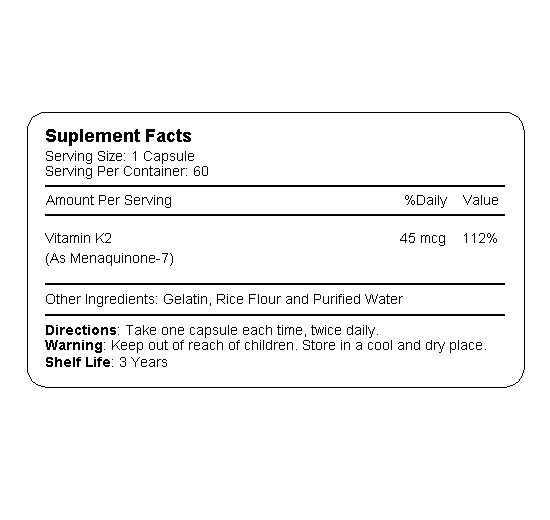纳豆 MK-7 (Natto MK-7)
产品简介
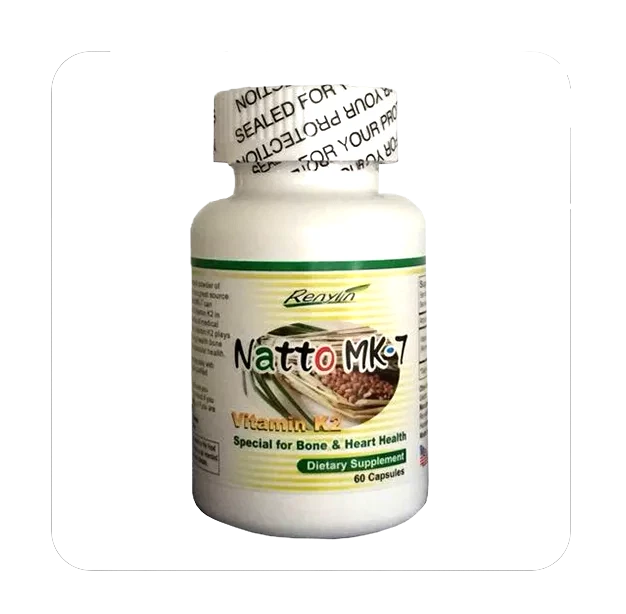
维生素K是一组结构相关的化合物,包括叶绿醌(维生素K1)和甲基萘醌(维生素K2)。甲基萘醌(维生素K2)又含有许多亚型,其中甲基萘醌-7(MK-7)是维生素K补充剂中生物利用度最高,持续时间最长且生物活性最强的形式之一。
许多年来,人们一直认为维生素K的功能与血液凝固有关。 然而,最近十年以来,维生素K2与两个最重要的健康问题联系起来:骨骼健康和心血管健康。 因此,钙的利用成为了人们关注的中心。
维生素K,特别维生素K2,帮助将钙带入其所应属的血液和骨骼,研究表明它可维持骨密度和血管弹性的正常水平。*
然而,大多数人缺乏保持骨骼和心血管组织健康所必需的维生素K,这是健康骨骼和心血管组织所必需的。 对于那些对骨骼生长最需要维生素K2的儿童来说,这尤其令人不安。
维生素K2已经在实验室,群体研究和临床试验中显示出比维生素K1更有效地预防骨质流失和促进骨完整性。 只有维生素K2可以显著降低动脉钙化的发生率并促进心血管健康。*
更多专业研究请参阅《临床研究》
本产品诚招经销商和批发商
- * 本声明未经美国食品药品管理局评估。 本产品不用于诊断,治疗或预防任何疾病。 本网站提供的信息仅供您一般参考,不能代替专业医疗建议或针对特定疾病的治疗。
临床研究
Here, you can read some of important published clinical research papers about MK-7 which support cardiovascular and bone health. Published peer reviewed studies can be accessed through PubMed at www.ncbi.nlm.nih.gov/pubmed. For more information, please contact Renylin Bio-Health Inc.
A High Intake of MK-7 Could Protect Against Coronary Heart Disease (CHD)
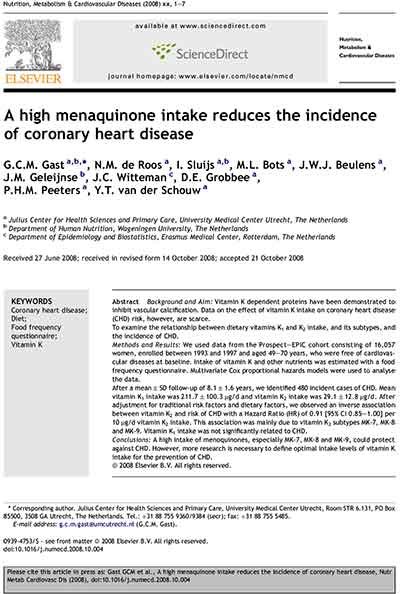
A high menaquinone intake reduces the incidence of
coronary heart disease
Abstract Background and Aim: Vitamin K dependent proteins have been demonstrated to inhibit vascular calcification. Data on the effect of vitamin K intake on coronary heart disease (CHD) risk, however, are scarce.
To examine the relationship between dietary vitamins K1 and K2 intake, and its subtypes, and the incidence of CHD.
Methods and Results: We used data from the ProspecteEPIC cohort consisting of 16,057 women, enrolled between 1993 and 1997 and aged 49e70 years, who were free of cardiovascular diseases at baseline. Intake of vitamin K and other nutrients was estimated with a food frequency questionnaire. Multivariate Cox proportional hazards models were used to analyse the data.
After a mean SD follow-up of 8.1 1.6 years, we identified 480 incident cases of CHD. Mean vitamin K1 intake was 211.7 100.3 mg/d and vitamin K2 intake was 29.1 12.8 mg/d. After adjustment for traditional risk factors and dietary factors, we observed an inverse association between vitamin K2 and risk of CHD with a Hazard Ratio (HR) of 0.91 [95% CI 0.85e1.00] per 10 mg/d vitamin K2 intake. This association was mainly due to vitamin K2 subtypes MK-7, MK-8 and MK-9. Vitamin K1 intake was not significantly related to CHD.
Conclusions: A high intake of menoquinones, especially MK-7, MK-8 and MK-9, could protect against CHD. However, more research is necessary to define optimal intake levels of vitamin K intake for the prevention of CHD.
Source:j.numecd.2008.10.004
Adequate Intake of Menaquinone Could Be Important For CHD Prevention
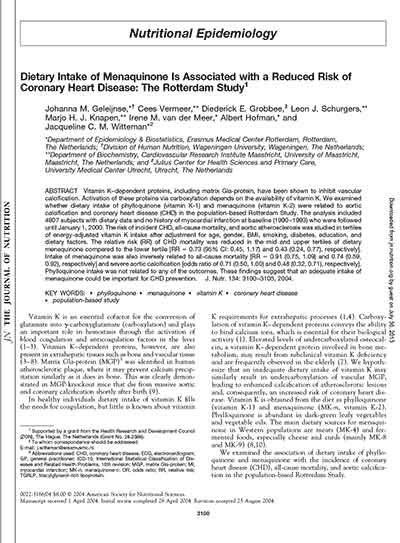
Dietary Intake of Menaquinone Is Associated with a Reduced Risk of Coronary Heart Disease: The Rotterdam Study
ABSTRACT
Vitamin K–dependent proteins, including matrix Gla-protein, have been shown to inhibit vascular calcification. Activation of these proteins via carboxylation depends on the availability of vitamin K. We examined whether dietary intake of phylloquinone (vitamin K-1) and menaquinone (vitamin K-2) were related to aortic calcification and coronary heart disease (CHD) in the population-based Rotterdam Study. The analysis included 4807 subjects with dietary data and no history of myocardial infarction at baseline (1990–1993) who were followed until January 1, 2000. The risk of incident CHD, all-cause mortality, and aortic atherosclerosis was studied in tertiles of energy-adjusted vitamin K intake after adjustment for age, gender, BMI, smoking, diabetes, education, and dietary factors. The relative risk (RR) of CHD mortality was reduced in the mid and upper tertiles of dietary menaquinone compared to the lower tertile [RR = 0.73 (95% CI: 0.45, 1.17) and 0.43 (0.24, 0.77), respectively]. Intake of menaquinone was also inversely related to all-cause mortality [RR = 0.91 (0.75, 1.09) and 0.74 (0.59, 0.92), respectively] and severe aortic calcification [odds ratio of 0.71 (0.50, 1.00) and 0.48 (0.32, 0.71), respectively]. Phylloquinone intake was not related to any of the outcomes. These findings suggest that an adequate intake of menaquinone could be important for CHD prevention.
Source:J Nutr. 2004 Nov;134(11):3100-5. https://www.ncbi.nlm.nih.gov/pubmed/15514282
Matrix Gla-Protein: The Calcification Inhibitor In Need of Vitamin K
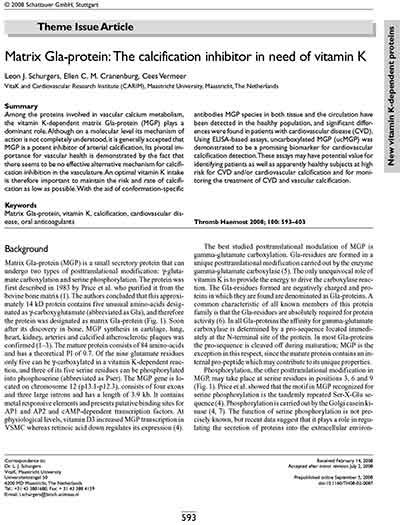
Matrix Gla-protein: The calcification inhibitor in need of vitamin K
Summary
Among the proteins involved in vascular calcium metabolism, the vitamin K-dependent matrix Gla-protein (MGP) plays a dominant role.Although on a molecular level its mechanism of action is not completely understood,it is generally accepted that MGP is a potent inhibitor of arterial calcification. Its pivotal importance for vascular health is demonstrated by the fact that there seems to be no effective alternative mechanism for calcification inhibition in the vasculature.An optimal vitamin K intake is therefore important to maintain the risk and rate of calcification as low as possible.With the aid of conformation-specific antibodies MGP species in both tissue and the circulation have been detected in the healthy population, and significant differences were found in patients with cardiovascular disease (CVD). Using ELISA-based assays, uncarboxylated MGP (ucMGP) was demonstrated to be a promising biomarker for cardiovascular calcification detection.These assays may have potential value for identifying patients as well as apparently healthy subjects at high risk for CVD and/or cardiovascular calcification and for monitoring the treatment of CVD and vascular calcification.
Source:Thromb Haemost. 2008 Oct;100(4):593-603. https://www.ncbi.nlm.nih.gov/pubmed/18841280<>
MK-7 Relation to Japanese Hip Fracture
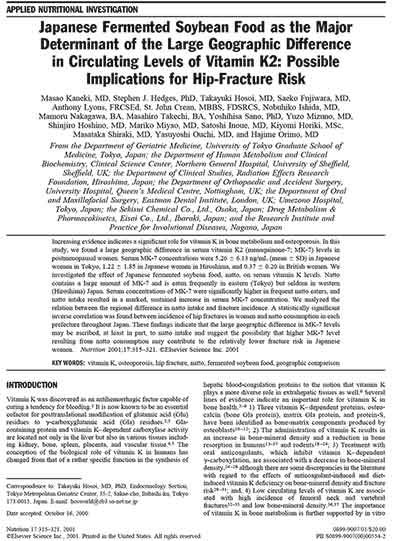
Japanese fermented soybean food as the major determinant of the large geographic difference in circulating levels of vitamin K2: possible implications for hip-fracture risk.
Abstract
Increasing evidence indicates a significant role for vitamin K in bone metabolism and osteoporosis. In this study, we found a large geographic difference in serum vitamin K2 (menaquinone-7; MK-7) levels in postmenopausal women. Serum MK-7 concentrations were 5.26 +/- 6.13 ng/mL (mean +/- SD) in Japanese women in Tokyo, 1.22 +/- 1.85 in Japanese women in Hiroshima, and 0.37 +/- 0.20 in British women. We investigated the effect of Japanese fermented soybean food, natto, on serum vitamin K levels. Natto contains a large amount of MK-7 and is eaten frequently in eastern (Tokyo) but seldom in western (Hiroshima) Japan. Serum concentrations of MK-7 were significantly higher in frequent natto eaters, and natto intake resulted in a marked, sustained increase in serum MK-7 concentration. We analyzed the relation between the regional difference in natto intake and fracture incidence. A statistically significant inverse correlation was found between incidence of hip fractures in women and natto consumption in each prefecture throughout Japan. These findings indicate that the large geographic difference in MK-7 levels may be ascribed, at least in part, to natto intake and suggest the possibility that higher MK-7 level resulting from natto consumption may contribute to the relatively lower fracture risk in Japanese women.
Source: Nutrition. 2001 Apr;17(4):315-21 www.ncbi.nlm.nih.gov/pubmed/11369171
MK-7 Prevention of Bone Deterioration With Aging
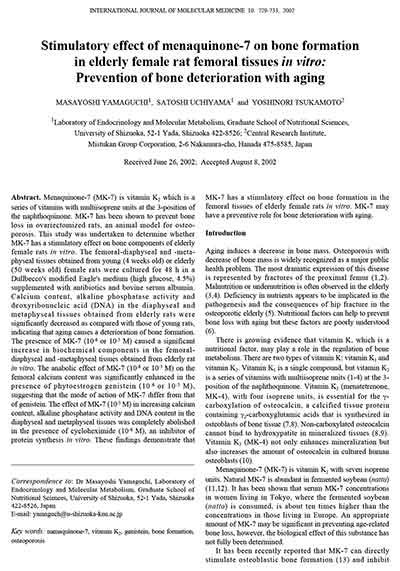
Stimulatory effect of menaquinone-7 on bone formation in elderly female rat femoral tissues in vitro: prevention of bone deterioration with aging.
Abstract
Menaquinone-7 (MK-7) is vitamin K2 which is a series of vitamins with multi-isoprene units at the 3-position of the naphthoquinone. MK-7 has been shown to prevent bone loss in ovariectomized rats, an animal model for osteoporosis.
This study was undertaken to determine whether MK-7 has a stimulatory effect on bone components of elderly female rats in vitro. The femoral-diaphyseal and -metaphyseal tissues obtained from young (4 weeks old) or elderly (50 weeks old) female rats were cultured for 48 h in a Dullbecco's modified Eagle's medium (high glucose, 4.5%) supplemented with antibiotics and bovine serum albumin.
Calcium content, alkaline phosphatase activity and deoxyribonucleic acid (DNA) in the diaphyseal and metaphyseal tissues obtained from elderly rats were significantly decreased as compared with those of young rats, indicating that aging causes a deterioration of bone formation.
The presence of MK-7 (10-6 or 10-5 M) caused a significant increase in biochemical components in the femoral-diaphyseal and -metaphyseal tissues obtained from elderly rat in vitro. The anabolic effect of MK-7 (10-6 or 10-5 M) on the femoral calcium content was significantly enhanced in the presence of phytoestrogen genistein (10-6 or 10-5 M), suggesting that the mode of action of MK-7 differ from that of genistein. The effect of MK-7 (10-5 M) in increasing calcium content, alkaline phosphatase activity and DNA content in the diaphyseal and metaphyseal tissues was completely abolished in the presence of cycloheximide (10-6 M), an inhibitor of protein synthesis in vitro. These findings demonstrate that MK-7 has a stimulatory effect on bone formation in the femoral tissues of elderly female rats in vitro. MK-7 may have a preventive role for bone deterioration with aging.
Source: INTERNATIONAL JOURNAL OF MOLECULAR MEDICINE 10: 729-733, 2002
Vitamin K2 In The Prevention of Hepatocellular Carcinoma In Women With Viral Cirrhosis
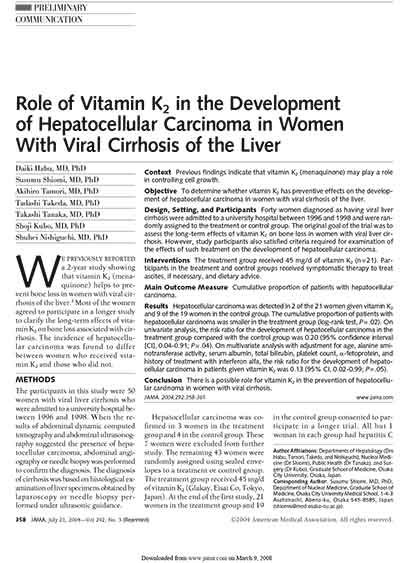
Role of Vitamin K2 in the Development of Hepatocellular Carcinoma in Women With Viral Cirrhosis of the Liver
Context Previous findings indicate that vitamin K2 (menaquinone) may play a role in controlling cell growth.
Objective To determine whether vitamin K2 has preventive effects on the development of hepatocellular carcinoma in women with viral cirrhosis of the liver.
Design, Setting, and Participants Forty women diagnosed as having viral liver cirrhosis were admitted to a university hospital between 1996 and 1998 and were randomly assigned to the treatment or control group. The original goal of the trial was to assess the long-term effects of vitamin K2 on bone loss in women with viral liver cirrhosis. However, study participants also satisfied criteria required for examination of the effects of such treatment on the development of hepatocellular carcinoma.
Interventions The treatment group received 45 mg/d of vitamin K2 (n=21). Participants in the treatment and control groups received symptomatic therapy to treat ascites, if necessary, and dietary advice.
Main Outcome Measure Cumulative proportion of patients with hepatocellular carcinoma.
Results Hepatocellular carcinoma was detected in 2 of the 21 women given vitamin K2 and 9 of the 19 women in the control group. The cumulative proportion of patients with hepatocellular carcinoma was smaller in the treatment group (log-rank test, P=.02). On univariate analysis, the risk ratio for the development of hepatocellular carcinoma in the treatment group compared with the control group was 0.20 (95% confidence interval [CI], 0.04-0.91; P=.04). On multivariate analysis with adjustment for age, alanine aminotransferase activity, serum albumin, total bilirubin, platelet count, -fetoprotein, and history of treatment with interferon alfa, the risk ratio for the development of hepatocellular carcinoma in patients given vitamin K2 was 0.13 (95% CI, 0.02-0.99; P=.05). Conclusion There is a possible role for vitamin K2 in the prevention of hepatocellular carcinoma in women with viral cirrhosis.
Source: JAMA. 2004;292:358-361
Vitamin K2: Putting Calcium Where It Belongs
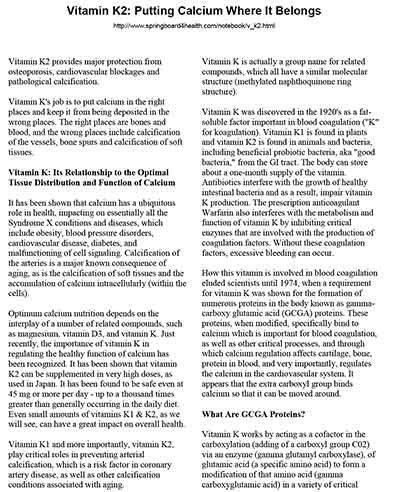
Vitamin K2: Putting Calcium Where It Belongs
Vitamin K2 provides major protection from osteoporosis, cardiovascular blockages and pathological calcification.
Vitamin K’s job is to put calcium in the right places and keep it from being deposited in the wrong places. The right places are bones and blood, and the wrong places include calcification of the vessels, bone spurs and calcification of soft tissues.
Source: http://www.springboard4health.com/notebook/v_k2.html
精选问答
MK-7(甲萘醌7)是发酵食品中发现的维生素K2的亚型之一。 甲基萘醌-7(维生素K2)是维生素K补充剂中生物利用度最高,持续时间最长且生物活性最强的形式之一。
多年来人们认为维生素K的功能仅仅与凝血有关。 然而,在最近十年以来,维生素K2与两个最重要的健康问题联系在一起了:骨骼健康和心血管健康。维生素K2(MK-7)帮助将钙带入血液和骨骼,研究表明维生素K2含量正常的情况下可以提高骨密度和改善血管弹性。*
简单地说,维生素K2有两个重要的基本功能:促进心血管健康和骨骼修复。维生素K2有助于预防骨质疏松症和动脉粥样硬化。此外,维生素K2的一些有价值的功能包括:
- 将钙导入骨骼等部位,使其更强壮,帮助预防蛀牙。它还可以防止钙进入错误的部位,例如肾脏,钙沉积在肾脏可能会导致肾结石,再如心脏,钙沉积血管壁可以造成动脉血管硬化,导致心脏病。*
- 通过增加男性的睾丸激素和生育能力,降低多囊卵巢综合征(PCOS)患者体内男性荷尔蒙水平进而优化性功能。*
- 制造胰岛素稳定血糖(保持系统对维持正确量的敏感度),预防糖尿病,以及帮助预防与肥胖相关的代谢问题。*
- 在加强促进健康基因的同时,抑制促进癌症的基因。*
- 在提高整体性能时,提高您利用能量的能力。*
荷兰的一项研究表明,基质Gla蛋白(MGP)是一种依赖维生素K2的蛋白质,是最有效的天然钙化抑制剂,但它需要活化。当身体有足够的维生素K2(特别是甲基萘醌-7,或MK-7,因为它是最具生物活性和可用形式的维生素K2)时,MGP会排斥钙沉积在动脉和血管中,使钙返回到血液中被其他系统利用,例如建造坚硬,高密度的骨骼。
鹿特丹进行的一项由4,809名荷兰成年人参加的研究表明,维生素K2摄入量最高的人群心脏病发作较少,主动脉钙化风险较低,死亡率最低。 这就是为什么自然疗法医生和作者Tal Friedman建议服用维生素K2补充剂,特别是MK-7的原因之一。
Tal Friedman补充道,维生素K2(MK-7)可显着减少绝经过渡期间的骨质流失,这一点对于绝经过渡期的女性来说尤其重要,这个阶段的女性骨流失的平均水平高达10%。
1. 心血管保健机理:
血管钙化与心血管疾病死亡率高度相关,特别是患有糖尿病和慢性肾病(CKD)的高风险患者。 血管钙化导致血管硬度增加和血管弹性降低。 几十年来,人们已经注意到血管钙化是衰老的结果。 现在的研究则证实血管钙化是一个主动调节的过程。基质Gla蛋白(MGP)是最强的动脉血管钙化抑制剂之一。 MGP具有与钙离子的高度亲和力,通过与钙离子结合将其从血管壁中分离出来,起到逆转动脉血管钙化的作用。但基质Gla蛋白的活性依赖维生素K2的参与,需要在维生素K2存在下被活化。 维生素K2激活基质GLA蛋白(MGP),后者抑制钙在血管壁上的沉积。*
2.骨骼保健机理:
成骨细胞产生骨钙素,骨钙素帮助吸收血液循环中的钙,并将其与骨基质结合。骨钙素与骨骼中矿物组分羟基磷灰石结合的能力大小对骨矿化的过程产生影响,羟基磷灰石使骨骼更强壮且不易骨折。 然而,新制成的骨钙素是无活性的,它需要维生素K2才能完全活化并结合钙。这种对维生素K2的依赖性,使维生素K2成为了骨骼健康的主要参与者。*
在实验动物中证实了通过摄入高剂量维生素K可以抑制血管钙化。在该实验模型中,比较了维生素K1和K2在预防动脉血管钙化中的功效。结果发现K2完全抑制组织钙化,而在同样剂量甚至采用8倍剂量的K1没有检测到抑制钙化的效果。
内容摘自:Spronk HM, et al. Tissue-specific utilization of menaquinone-4 results in the prevention of arterial calcification in warfarin-treated rats. J Vasc Res 2003; 40:531–537.
- * 本声明未经美国食品药品管理局评估。 本产品不用于诊断,治疗或预防任何疾病。 本网站提供的信息仅供您一般参考,不能代替专业医疗建议或针对特定疾病的治疗。




